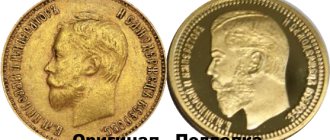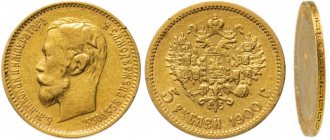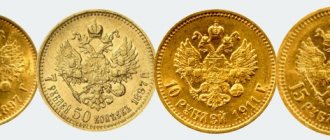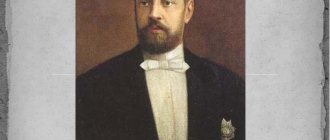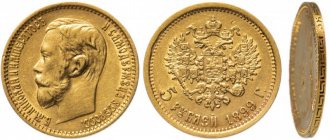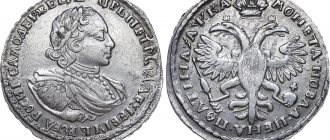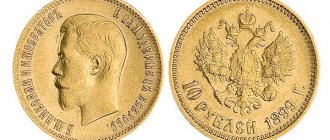I wish you health and prosperity, dear readers! The era of banknotes made of gold and silver is a thing of the past, but interest in the ancient artifacts that remain from it continues.
Gold coins of Nicholas II are especially popular among investors and collectors. Among them there are examples of truly fabulous value and exceptional rarity. There are also many relatively inexpensive items that nevertheless have historical and antique value that increases over the years.
Types and characteristics of coins
During the reign of Emperor Nicholas II, gold coins were minted from 1897 to 1911. They were made from an alloy containing 9 parts of pure gold and 1 part of copper as an alloying metal, from which the alloy had a characteristic reddish tint. There are three main categories of gold coins issued during this period:
- For use directly in Russia.
- For settlements on the territory of Finland, which at that time was part of the Russian Empire.
- Commemorative (donative) coins dedicated to a significant event were used as personal gifts from Nicholas II to the courtiers.
For the Russian Empire
These coins were minted annually in huge quantities and had a similar design. The obverse traditionally featured the profile of Emperor Nicholas II, and the reverse featured the coat of arms of the empire.
They differed in the dates of minting, the initials of the mintmasters, denomination and weight. Gold coins were issued in denominations:
- 5 rubles – diameter 1.84 cm, weight 4.3 g;
- 10 rubles – diameter 2.25 cm, weight 8.6 g;
- 7.5 rubles – diameter 2.14 cm, weight 6.45 g;
- 15 rubles – diameter 2.44 cm, weight 12.9 g.
For Finland
A separate monetary unit - marks - was minted for settlements in Finland. The coins were issued in two denominations: 10 and 20 marks. The diameter of the gold ones was 1.91 and 2.14 cm, and the weight was 3.23 and 6.45 g, respectively. The Russian coat of arms, the inscriptions “FINLAND”, “SUOMI” are engraved on the obverse; the name, denomination, and year of minting are on the reverse.
Donation coins
The donative gold coins of Nicholas II include the so-called imperials. The first samples were released in 1895. The semi-imperial (5 rubles) and the imperial (10 rubles) had a key difference - the weight was one third greater than the gold ones made subsequently. Their production was very small: 36 semi-imperials were produced, and 125 imperials were produced.
Twenty-five rubles, or 2.5 imperials, were issued twice: in 1896, in honor of the coronation of Nicholas II, in the amount of 301 pieces. For the Tsar's fortieth anniversary in 1908, another 175 copies were minted.
Another commemorative coin had the largest denomination - 37.5 rubles, or 100 francs. It was also made exclusively for presents of Nicholas II in the amount of 235 pieces. Diameter - 3.22 cm, weight - 32.26 grams, of which more than 29 grams are pure gold.
Nikolaevsky Chervonets: issue price
The price of the royal chervonets is directly related to its authenticity. Since there are dozens of times more fakes than originals, the average price for this banknote on the market is close to the actual price tag for the gold it contains. Therefore, it will be 30 thousand rubles.
For example, a Nikolaev chervonets from 1899, when bought in the capital, costs from 17 to 25 thousand rubles. The same prices are set for royal coins of 1898, 1900-1903. For a real 1904 coin they can offer from 24 thousand rubles. up to 35 thousand. The red coin of 1906 is a rare specimen. A 10-ruble coin of 1909 is estimated at 30-45 thousand rubles, the next year is the most expensive - from 55 to 125 thousand rubles. And the royal coin of 1911 - 17-25 thousand rubles.
The red gold coin with the image of Nicholas 2 is small in size. The diameter of the royal chervonets is 22.6 mm, weight is 8.6 grams. The gold content of 900 purity is 7.74 grams. On the obverse we see a bust of Nicholas 2 framed by letters, on the reverse there is a small coat of arms, under which the year of minting and the denomination are noted.
Minting was carried out in large quantities, except for 1906-1907.
In turn, the minting on the edge of a gold coin can tell a lot. As mentioned, part of the circulation was produced abroad. One star on the edge of a red gold coin indicates that the coin was minted in Paris, while two stars indicate that it was minted in Brussels.
The rarest and most expensive gold coins of the era of Nicholas II
The highest prices are found in copies whose production was not in the millions, but in hundreds or even tens of pieces. In addition to donated coins, we can highlight gold 5 and 10 rubles issued from 1905 to 1907, since at that time, due to the Russo-Japanese War and after the revolution, Nicholas II ordered the minting of money from precious metals to be reduced to minimum circulations. Thus, in 1906, only 10 pieces of gold 5 and 10 rubles were produced, and in 1907, 109 gold fives were issued.
Expert opinion
Alexander Ivanovich
Private collector with 4500+ coins and bonds in his personal collection. Knows the value of each of them today.
Most coins of the Nicholas era were issued in colossal, million-dollar quantities, since they were intended for cash payments. Not many copies have survived in excellent condition. Such items are especially highly valued.
A unique example of coins from the time of Nicholas II, without exaggeration, is test banknotes - russ. They did not go into circulation, but 5 sets were produced.
Prices for redemption/purchase of gold coins of Nicholas II
| Year | 5 rubles | 7 rubles 50 kopecks. | 10 rubles | 15 rubles |
| 1897 | from 20,000 rub. | from 47,000 rub. | from 65,000 rub. | |
| 1898 | from 20,000 rub. | from 40,000 rub. | — | |
| 1899 | from 20,000 rub. | — | from 40,000 rub. | — |
| 1900 | from 20,000 rub. | — | from 40,000 rub. | — |
| 1901 | from 20,000 rub. | — | from 40,000 rub. | — |
| 1902 | from 21,000 rub. | — | from 41,000 rub. | — |
| 1903 | from 21,000 rub. | — | from 41,000 rub. | — |
| 1904 | from 22,000 rub. | — | from 43,000 rub. | — |
| 1909 | from 30,000 rub. | — | from 47,000 rub. | — |
| 1910 | from 65,000 rub. | — | from 90,000 rub. | — |
| 1911 | from 130,000 rub. | — | from 41,000 rub. | — |
Sell coins
Is it worth investing in gold coins?
This type of investment undoubtedly deserves attention. Even if the demand for antiques remains unchanged, the price of your investment will also depend on how much the gold itself is worth. However, this way to earn money has its own characteristics.
Advantages and disadvantages
Investing money in antiques is a profitable business, but you have to choose one of two: either invest a lot and receive income within 10 years, or spend relatively little, but provide a future only for your grandchildren. The value of royal gold money from the era of Nicholas II will only increase over the years, but for common items - more slowly than we would like.
It is impossible to say for sure which outweighs: investing in gold coins has both pros and cons. To the negative aspects, I would also add the complexity of purchasing, low liquidity and the need to ensure the storage of each copy.
Currency reform in Russia
At the beginning of the reign of Nicholas II, Sergei Witte was appointed to the post of Minister of Finance, who carried out the monetary reform. The main goal of the reform was to strengthen the national currency, which was backed by gold. Thus, the number of paper bills decreased, and the amount of precious metal money increased.
Therefore, there was a need to increase gold production and mint new Nikolaev coins. Due to the great need and volume of coinage, the mints of Brussels and Paris began to issue part of the money.
Where can you buy or sell
A common and reliable way to buy or sell antique gold coins is through auction houses. They not only organize auctions, but also conduct examinations and evaluations of samples, so there is no chance of getting a fake. And such items are very often counterfeited due to their high cost. The most reputable auction house selling numismatics is Wolmar.
Buying and selling money from the era of Nicholas II is the prerogative of antique and numismatic stores. Experienced treasure hunters try to avoid these traders, since they rarely offer a decent price for the goods. But there are exceptions, for example the famous “Numismatist” and the adjacent flea market in Moscow.
Another way to buy or sell antique gold is through numismatic societies and portals. Among the regulars of such communities, you can find a buyer or seller, and also gain a lot of useful information.
Price of gold coins from the time of Nicholas II
To get an idea of how much gold banknotes from the time of Nicholas II are worth today, take a look at the table.
Rules for purchasing coins
But before buying or selling coins from that period, you need to be careful, since those coins are the most likely to be counterfeited. Only professional numismatists and appraisers can tell the value of a piece. There is also confusion with coin mintages. The thing is that a certain quantity could have been in the warehouse before being put into use, so it is difficult to name the exact number of copies.
Most often among counterfeit coins there are copies from the reign of Nicholas II. In addition, these variations are completely identical to the originals and look more beautiful because they were minted recently. There are several explanations for this number of fakes:
- During the revolution, confusion and chaos reigned at the mint, so nothing is known about the fate of the stamps. There were rumors about the location of the stamps that they were captured by Admiral Kolchak in order to mint coins for the needs of the White Army.
- The Soviet government continued to mint coins and sold them abroad. Thus, the gold reserves of the Russian Empire were squandered, and copies were sold in the West.
- Someone made copies of the royal stamps and continues to make money that is completely fake.
But even the new ones are clearly made according to the standards and canons, so they are more profitable to purchase than gold bars with an unknown hallmark of that time.
Purchasing coins from the time of Nicholas II, the last emperor of Russia, is a profitable investment. The number of coins and their price variety allows you to purchase the desired copy to replenish your collection. A purchase is considered safe if the product has a certificate of authenticity, and the process itself does not take place “by hand”, but at an auction. The value of coins increases every year, but such an investment requires care as the pieces require cleaning.
The Last Emperor: From the History of a Great Country
The reign of Emperor Nicholas II took place from 1894 to 1917 – difficult and controversial years for the people and the country as a whole. Nicholas II became the last emperor, and with him a great era that lasted more than three hundred years sank into oblivion.
On the eve of the First World War and the October Revolution, Russia reached its peak and was one of the most powerful powers in the world. Military affairs, mechanical engineering, oil and metallurgical industries were actively developing. All this, naturally, entailed the development of coin production. At that time, the St. Petersburg Mint functioned in the empire, where all the banknotes of the empire were minted. And there was something to mint: kopecks (1/4, ½, 1, 2, 3, 5, 10, 15, 25, 50), rubles (ruble, 5, 7.5, 10, 15, 25). Copper, silver and gold coins were issued.
